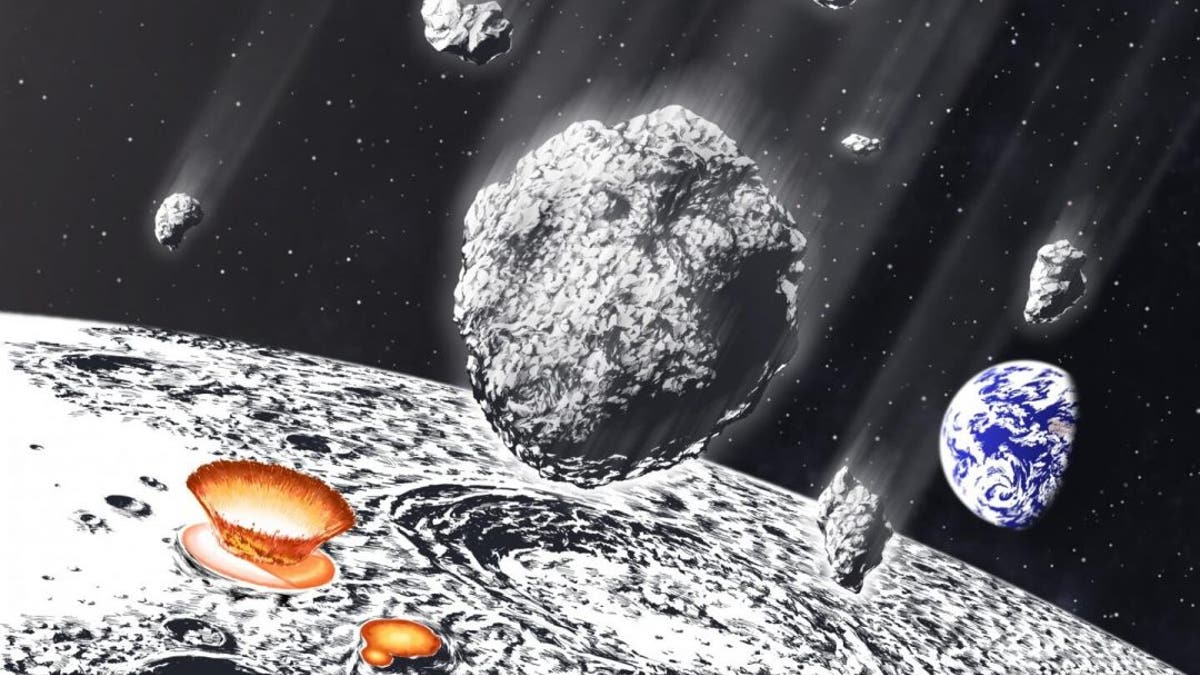Fox News Flash top headlines for July 21
Fox News Flash top headlines are here. Check out what's clicking on Foxnews.com.
Eight hundred million years ago, a 62-mile-wide asteroid broke apart and sent 110 trillion pounds of meteorites crashing into the moon and the Earth, according to a new study.
As part of the asteroid disruption, the researchers said it's possible that it resulted in a 10 mile-wide asteroid hitting the Earth and caused the extinction of the dinosaurs, citing the thin layer of iridium enrichment (a metal commonly seen in asteroids) found around the world.
"Our research results have provided a novel perspective on earth science and planetary science," the study's lead author, Kentaro Terada, said in a statement. "They will yield a wide range of positive effects in various research fields."

An asteroid shower on the Earth-Moon system. (Credit: Artist's illustration, credit: Murayama/Osaka Univ)
GIANT METEORITE IMPACTS FORMED PARTS OF MOON'S CRUST, SCIENTISTS REVEAL
The study was published in the scientific journal Nature Communications.
"Meteoroid bombardment of the Earth-Moon system must have caused catastrophic damage to the terrestrial ecosphere," the researchers added in the study's abstract.
The researchers analyzed 59 lunar craters using the Terrain Camera on the Kaguya spacecraft to come up with their findings. The craters that were analyzed all had diameters of 12 miles or more.
The experts also noted the 110 trillion pounds of meteoroids that impacted the Earth and moon were "approximately 30–60 times more than the Chicxulub impact."
That asteroid, known as the Chicxulub impact event, killed off 75 percent of all life on Earth, and it also produced a massive hydrothermal system filled with magma, according to a recently published study.
A 62-mile-wide asteroid may have been "catastrophic," the researchers wrote in the study, but humanity shouldn't fret about an asteroid this size hitting the planet anytime soon. "The probability of an asteroid of this size striking Earth is thought to be once in 100 million years," according to the statement.
WHAT SHOULD WE DO IF A 'PLANET-KILLER' ASTEROID TAKES AIM AT EARTH?
NASA has been preparing for planetary defense from asteroid strikes for years. A recent survey showed that Americans prefer a space program that focuses on potential asteroid impacts over sending humans back to the moon or to Mars.
In April 2019, NASA awarded a $69 million contract to SpaceX, the space exploration company led by Elon Musk, to help it with asteroid deflection via its DART mission.
NASA has recently expanded its planetary defense protocols, including a bold new plan to protect Earth. In June 2018, NASA unveiled a 20-page plan that details the steps the U.S. should take to be better prepared for Near Earth Objects (NEOs) such as asteroids and comets that come within 30 million miles of the planet.
"Potentially hazardous" NEOs are defined as space objects that come within 0.05 astronomical units and measure more than 460 feet in diameter, according to NASA.
According to a 2018 report put together by Planetary.org, there are more than 18,000 NEOs.
NASA Administrator Jim Bridenstine has warned that an asteroid strike is not something to be taken lightly and is perhaps Earth's biggest threat.
"We have to make sure that people understand that this is not about Hollywood, it's not about movies," Bridenstine said at the International Academy of Astronautics' 2019 Planetary Defense Conference in College Park, Md., according to Space.com. "This is about ultimately protecting the only planet we know right now to host life, and that is the planet Earth."

